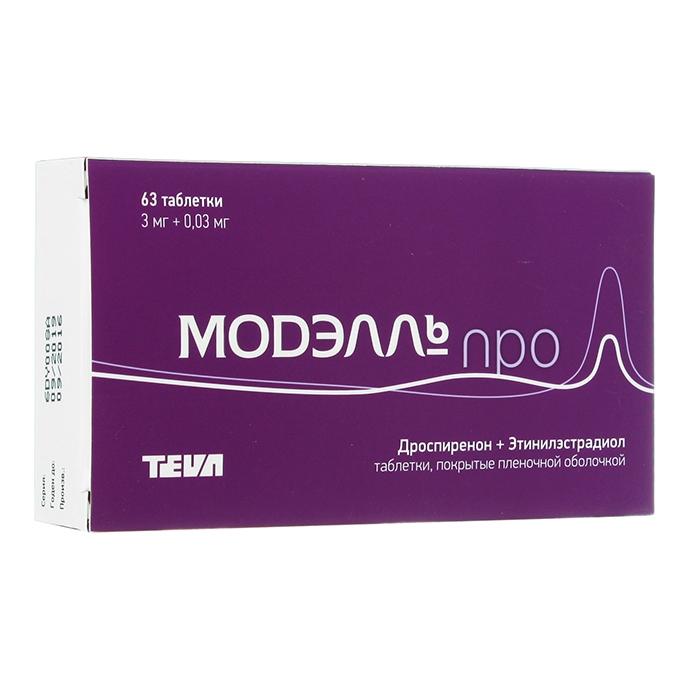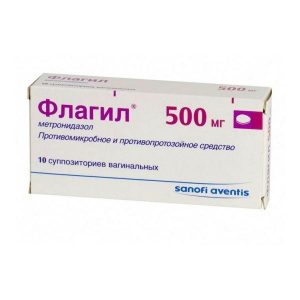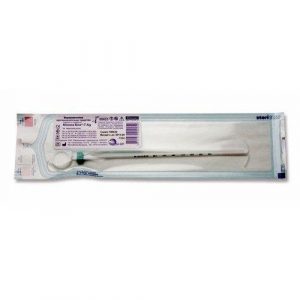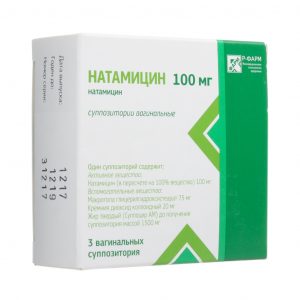Description
Pharmacological action
Low-dose combined monophasic oral hormonal contraceptive containing ethinyl estradiol and drospirenone.
The contraceptive effect of MODELL PRO is mainly due to the suppression of ovulation, increased viscosity of cervical mucus and changes in the endometrium. In women taking combined oral contraceptives (CPC), the menstrual cycle becomes more regular, painful menstruation is less frequent, the intensity of menstrual bleeding decreases, which reduces the risk of iron deficiency anemia. In addition, there is evidence of a reduced risk of developing endometrial cancer and ovarian cancer.
Drospirenone contained in MODELL PRO, It has an antimineralocorticoid effect and is able to prevent an increase in body weight and the appearance of other symptoms (for example, peripheral edema) associated with hormone-dependent fluid retention. Drospirenone also has antiandrogenic activity and helps to reduce acne (acne), oily skin and hair. This action of drospirenone is similar to the action of natural progesterone produced in the female body. This should be considered when choosing a contraceptive, especially for women with hormone-dependent fluid retention, as well as for women with acne and seborrhea.
When used correctly, the Pearl index (an indicator that reflects the number of pregnancies in 100 women who use contraceptives during the year) is less than 1. If the pill is missed or if it is used incorrectly, the Pearl index may increase.
Indications
– contraception.
Contraindications
– current or history of thrombosis (venous and arterial) (including deep vein thrombosis, pulmonary embolism, myocardial infarction, cerebrovascular disorders)
– conditions that are prior to thrombosis ischemic attacks, atrial fibrillation, angina pectoris) currently or in the history of
– migraine with focal neurological symptoms now or in the history of
– diabetes mellitus with vascular complications
– multiple or severe risk factors for venous or arterial thrombosis (including complicated valvular heart disease , atrial fibrillation, diseases of the vessels of the brain or coronary arteries uncontrolled arterial hypertension, prolonged immobilization, extensive surgery, surgical interventions lstva on the lower extremities, extensive trauma, smoking, older than 35 years, obesity with a BMI> 30 kg / m2)
– pancreatitis with severe hypertriglyceridemia at present or in the history of
– liver failure and severe liver diseases (before normalization of liver function indicators)
– liver tumors (benign or malignant) at present or in the history of
– acute severe renal failure and severe renal failure
– identified hormone-dependent malignant diseases (including genital organs or mammary glands) or suspected
of them – vaginal bleeding is not idiopathic genesis
– Pregnancy or suspected it
– lactation (breastfeeding)
– hereditary lactose intolerance, lactase deficiency syndrome or glucose-galactose malabsorption
– hypersensitivity to the drug.
If any of the above diseases or conditions develop for the first time while taking the drug, then you should immediately cancel it.
Caution
The ratio of potential risk and the expected benefit of using MODELL PRO in each individual case should be assessed in the presence of the following diseases / conditions and risk factors:
– risk factors for thrombosis and thromboembolism: smoking, obesity (BMI2), dyslipoproteinemia, controlled arterial hypertension, migraine without focal neurological symptoms, uncomplicated heart valve defects, hereditary predisposition to thrombosis (thrombosis, myocardial infarction or impaired cerebral circulation at a young age in any of the next of kin)
– other diseases, in which peripheral circulatory disorders may occur: diabetes mellitus without diabetic angiopathy, SLE, hemolytic uremic syndrome, Crohn’s disease and ulcerative colitis, sickle cell anemia, superficial vein phlebitis
– hereditary angioedema
– hypertriglyceridemia – non-hypertriglyceridemia contraindications
– diseases that first occurred or worsened during pregnancy or against the background of previous use of sex hormones (for example, jaundice and / or itching associated with x lestazom, cholelithiasis, otosclerosis with hearing impairment, porphyria, herpes gestationis, Sydenham’s chorea)
– postpartum period.
Use during pregnancy and lactation
Pregnancy
If pregnancy is detected while taking MODELL PRO, the drug should be stopped immediately. Extensive epidemiological studies have not revealed an increased risk of developmental defects in children born to women who received sex hormones before pregnancy, or teratogenic effects in cases when sex hormones were taken by negligence in the early stages of pregnancy. In animal studies, the effects of drospirenone and ethinyl estradiol have been associated with their pharmacological effects. In particular, in studies of reproductive toxicity in animals, an embryotoxic and fetotoxic effect was revealed, but these effects were considered as related to the specifics of a particular animal species. At exposure levels in animals exceeding the corresponding levels in women taking drospirenone and ethinyl estradiol, the effect on the sex differentiation of rat embryos was observed, which was absent in small monkeys. According to the data, obtained in animal studies, it is impossible to exclude the possibility of developing undesirable effects caused by hormonal activity of active substances in humans. However, the combined experience with CPC during pregnancy did not provide evidence of the development of undesirable effects in humans. Data on the results of taking MODELL PRO during pregnancy is limited, which does not allow us to draw any conclusions about the negative effect of the drug on pregnancy, the health of the fetus and the newborn. Currently, no significant epidemiological data are available.
Lactation
The drug is contraindicated in the period of breastfeeding. It can reduce the amount of breast milk and change its composition, so the use of the drug is not recommended until the termination of breastfeeding. A small amount of sex hormones and / or their metabolites can be excreted in breast milk, but there is no evidence of their negative effects on the health of the child.
Special instructions
Before starting or resuming the use of MODELL PRO, you need to familiarize yourself with the history of life, the family history of the woman, conduct a thorough general medical (including measurement of blood pressure, heart rate, determination of BMI) and gynecological examination, including breast examination and cytological examination of the neck scraping uterus (Pap test), exclude pregnancy. The volume of additional studies and the frequency of control examinations are determined individually. Typically, control examinations should be performed at least 1 time in 6 months.
A woman should be informed that MODELL PRO does not protect against HIV infection (AIDS) and other sexually transmitted diseases.
If any of the conditions, diseases and risk factors listed below are present, you should carefully consider the potential risk and expected benefits of using CCP in each individual case and discuss it with a woman before she decides to start taking the drug . With weighting, strengthening, or at the first manifestation of risk factors, withdrawal of the drug may be required.
Diseases of the cardiovascular system
The results of epidemiological studies indicate a relationship between the use of CPC and an increase in the incidence of venous and arterial thrombosis and thromboembolism, such as deep vein thrombosis, pulmonary embolism, myocardial infarction, cerebrovascular disease. These diseases are rare. The risk of developing venous thromboembolism (VTE) is maximum in the first year of taking such drugs. An increased risk is present after the initial use of CPC or the resumption of the use of the same or different CPC (after a break between doses of 4 weeks or more). The results of a large prospective study involving 3 groups of patients show that this increased risk is present mainly during the first 3 months.
The general risk of VTE in patients taking low-dose CPC (containing
VTE, which manifests itself as deep vein thrombosis or pulmonary embolism, may develop with the use of any CPC.
It is extremely rare to use thrombosis of other blood vessels, for example, liver blood vessels , renal, cerebral veins, and arteries or vessels of the retina There is no consensus on the relationship between the occurrence of these events and the use of CPC
Symptoms of deep vein thrombosis (DVT) include: unilateral tech lower extremities or along veins in the lower limbs, pain or discomfort in the lower limb in a vertical position or during walking, the local temperature rise in the affected lower limb, redness or discoloration of the skin on the lower extremities.
Symptoms of pulmonary embolism (pulmonary embolism): shortness of breath or rapid breathing, sudden cough, incl. with hemoptysis, acute pain in the chest, which may intensify with a deep breath, anxiety, severe dizziness, rapid or irregular heartbeat. Some of these symptoms (e.g., shortness of breath, cough) are nonspecific and may be misinterpreted as symptoms of other more or less severe events (e.g., respiratory tract infection).
Arterial thromboembolism can lead to stroke, vascular occlusion, or myocardial infarction. Symptoms of a stroke: sudden weakness or loss of sensitivity of the face, limbs, especially on one side of the body, sudden confusion, speech and understanding problems, sudden one- or two-sided loss of vision, sudden impaired gait, dizziness, loss of balance or coordination of movements sudden, severe or prolonged headache for no apparent reason, loss of consciousness or fainting with or without an epileptic seizure. Other signs of vascular occlusion: sudden pain, swelling and weak blueness of the limbs, symptom complex acute abdomen.
Symptoms of myocardial infarction include: pain discomfort, feeling of pressure, heaviness, feeling of constriction or fullness in the chest, arm or chest, discomfort in the left half of the chest radiating to the back, cheekbone, larynx, arm, epigastric region, cold sweat, nausea, vomiting or dizziness, severe weakness, anxiety, or shortness of breath rapid or irregular heartbeat.
Arterial thromboembolism can be fatal.
The risk of thrombosis (venous and / or arterial) and thromboembolism increases:
– with age
– in smokers (with an increase in the number of cigarettes or an increase in age, the risk increases, especially in women over 35)
– with obesity (BMI> 30 kg / m2)
– in the presence of a burdened family history (e.g., venous or arterial thromboembolism at close relatives or parents at a relatively young age). In the case of a hereditary or acquired predisposition, a woman should be referred to the appropriate specialist to resolve the issue of the possibility of using CPC
– with prolonged immobilization, serious surgical intervention, any surgery on the lower extremities or extensive injury. In these situations, it is advisable to discontinue the use of CPC (in the case of the planned operation, at least 4 weeks before it) and not resume taking it within 2 weeks after the end of
immobilization – for
dyslipoproteinemia – for
arterial hypertension – for
migraine – for heart valve disease
– with atrial fibrillation.
The question of the possible role of varicose veins and superficial thrombophlebitis in the development of venous thromboembolism remains controversial. You should take into account the increased risk of developing thromboembolism in the postpartum period.
Peripheral circulatory disorders can also occur in diabetes mellitus, SLE, hemolytic-uremic syndrome, chronic inflammatory bowel disease (Crohn’s disease or ulcerative colitis) and sickle cell anemia.
An increase in the frequency and severity of migraine attacks during the use of CPC (which may precede cerebrovascular disorders) should be the reason for the immediate cessation of these drugs.
Biochemical indicators indicating a hereditary or acquired predisposition to venous or arterial thrombosis include: resistance to activated protein C, hyperhomocysteinemia, antithrombin III deficiency, protein C deficiency, protein S deficiency, the presence of antibodies to phospholipids (anti-cardiolipin antibodies, )
When assessing the risk-benefit ratio, it should be borne in mind that adequate treatment of the condition can reduce the risk of thrombosis associated with it. It should also be borne in mind that the risk of thrombosis and thromboembolism during pregnancy is higher, than when taking low-dose CPC (containing less than 50 micrograms of ethinyl estradiol).
Medications containing levonorgestrel, norgestimate or norethindrone have a low risk of developing venous thromboembolism. For drugs that include drospirenone, the risk of developing thromboembolic complications is 2 times higher, and therefore a woman should be warned about this increased risk before prescribing MODELL PRO.
Tumors
The most significant risk factor for cervical cancer is persistent papillomavirus infection. There are reports of a slight increase in the risk of developing cervical cancer with prolonged use of CPC. However, the connection with taking the CCP has not been proven. Inconsistent data regarding the extent to which these data are associated with screening for the detection of pathology of the cervix or with features of sexual behavior (a more rare use of barrier methods of contraception).
A meta-analysis of 54 epidemiological studies showed that there is a slightly increased relative risk of developing breast cancer diagnosed in women currently taking CPC (relative risk 1.24). The increased risk gradually disappears within 10 years after stopping these drugs. Due to the fact that breast cancer is rare in women under 40 years of age, an increase in the number of breast cancer diagnoses in women who are currently or recently taking CPC is negligible in relation to the overall risk of this disease. The relationship between the development of milk cancer
A meta-analysis of 54 epidemiological studies showed that there is a slightly increased relative risk of developing breast cancer diagnosed in women currently taking CPC (relative risk 1.24). The increased risk gradually disappears within 10 years after stopping these drugs. Due to the fact that breast cancer is rare in women under 40 years of age, an increase in the number of breast cancer diagnoses in women who are currently or recently taking CPC is negligible in relation to the overall risk of this disease. The relationship between the development of milk cancer
A meta-analysis of 54 epidemiological studies showed that there is a slightly increased relative risk of developing breast cancer diagnosed in women currently taking CPC (relative risk 1.24). The increased risk gradually disappears within 10 years after stopping these drugs. Due to the fact that breast cancer is rare in women under 40 years of age, an increase in the number of breast cancer diagnoses in women who are currently or recently taking CPC is negligible in relation to the overall risk of this disease. The relationship between the development of milk cancer 24). The increased risk gradually disappears within 10 years after stopping these drugs. Due to the fact that breast cancer is rare in women under 40 years of age, an increase in the number of breast cancer diagnoses in women who are currently or recently taking CPC is negligible in relation to the overall risk of this disease. The relationship between the development of milk cancer 24). The increased risk gradually disappears within 10 years after stopping these drugs. Due to the fact that breast cancer is rare in women under 40 years of age, an increase in the number of breast cancer diagnoses in women who are currently or recently taking CPC is negligible in relation to the overall risk of this disease. The relationship between the development of milk cancerth gland and taking CCP is not proven. The observed increased risk may also be the result of careful observation and earlier diagnosis of breast cancer in women using CPC. In women who have ever used CPC, I detect
Composition
Tablets, film coated with light yellow colors, round, biconvex, marked D3 on one side, applied cross-section embossing house core from white to almost white.
1 tab.
ethinyl estradiol 30 μg
drospirenone 3 mg
Excipients: lactose monohydrate – 43.37 * mg, corn starch – 12.8 mg, pregelatinized starch – 15.4 mg, povidone K25 – 3.4 mg, croscarmellose sodium – 1.6 mg.
Shell composition: opadry yellow 03B38204 – 2 mg (hypromellose 6cP – 62.5%, titanium dioxide – 29.5%, macrogol 400 – 6.25%, yellow iron oxide dye – 1.75%).
* the amount of lactose monohydrate may vary depending on the purity of the substance of the active substance.
Side effects
The frequency of adverse reactions that were identified with the use of the drug is determined as follows: often ( 1 / 100-
from the immune system: rarely – bronchial asthma, hypersensitivity reactions.
From the nervous system: often a headache.
Mental disorders: often – a depressive state is infrequent – a change in libido.
On the part of the hearing organ: rarely – hearing loss.
From the cardiovascular system: often – migraine infrequently – increased blood pressure, low blood pressure rarely – thromboembolism.
From the digestive system: often – nausea infrequently – vomiting, diarrhea.
From the skin and subcutaneous tissues: infrequently – acne, eczema, itching rarely – erythema nodosum, erythema multiforme.
On the part of the reproductive system and mammary gland: often – menstrual irregularities, acyclic bleeding, tenderness of the mammary glands, increased sensitivity of the mammary gland, leucorrhoea, vulvovaginal candidiasis infrequently – breast enlargement, vaginitis rarely – discharge from the mammary glands.
Other: infrequently – fluid retention, change in body weight.
The following serious adverse events have been reported in women taking CPC: venous thromboembolism, arterial thromboembolism, increase in blood pressure of a liver tumor or worsening of conditions whose association with CPC has not been conclusively established (Crohn’s disease, ulcerative colitis, epilepsy, migraine, uterine fibroids, porphyria, SLE, herpes in a previous pregnancy, Sydenham chorea, hemolytic uremic syndrome, cholestatic jaundice) chloasma.
In women with hereditary angioedema, the use of estrogen can cause or aggravate its symptoms.
Overdose of
No serious violations of the overdose have been reported.
Symptoms: nausea, vomiting, spotting spotting from the vagina, or metrorrhagia may be observed on the basis of experience with the use of CPC in case of an overdose.
Treatment: there is no specific antidote for symptomatic treatment.
Storage conditions
The drug should be stored out of the reach of children at a temperature not exceeding 25 ° C.
Expiration
3 year
Deystvuyuschee substances
dimethicone, Ethinyl estradiol
Conditions of dispatch from
pharmacies Prescription
dosage form
tablets
Appointment
Adult by doctor’s appointment, For women, For women of childbearing age
Indications
For contraception
Oman Pharmaceutical Products Co., Oman Sultanate




